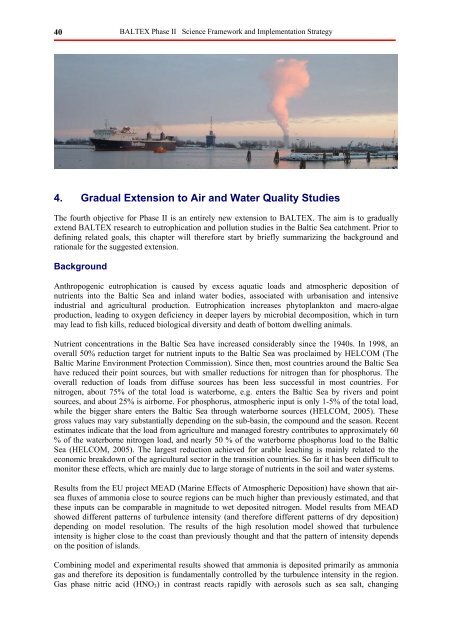BALTEX Phase II 2003 â 2012. Science Framework and ...
BALTEX Phase II 2003 â 2012. Science Framework and ...
BALTEX Phase II 2003 â 2012. Science Framework and ...
You also want an ePaper? Increase the reach of your titles
YUMPU automatically turns print PDFs into web optimized ePapers that Google loves.
40<br />
<strong>BALTEX</strong> <strong>Phase</strong> <strong>II</strong> <strong>Science</strong> <strong>Framework</strong> <strong>and</strong> Implementation Strategy<br />
4. Gradual Extension to Air <strong>and</strong> Water Quality Studies<br />
The fourth objective for <strong>Phase</strong> <strong>II</strong> is an entirely new extension to <strong>BALTEX</strong>. The aim is to gradually<br />
extend <strong>BALTEX</strong> research to eutrophication <strong>and</strong> pollution studies in the Baltic Sea catchment. Prior to<br />
defining related goals, this chapter will therefore start by briefly summarizing the background <strong>and</strong><br />
rationale for the suggested extension.<br />
Background<br />
Anthropogenic eutrophication is caused by excess aquatic loads <strong>and</strong> atmospheric deposition of<br />
nutrients into the Baltic Sea <strong>and</strong> inl<strong>and</strong> water bodies, associated with urbanisation <strong>and</strong> intensive<br />
industrial <strong>and</strong> agricultural production. Eutrophication increases phytoplankton <strong>and</strong> macro-algae<br />
production, leading to oxygen deficiency in deeper layers by microbial decomposition, which in turn<br />
may lead to fish kills, reduced biological diversity <strong>and</strong> death of bottom dwelling animals.<br />
Nutrient concentrations in the Baltic Sea have increased considerably since the 1940s. In 1998, an<br />
overall 50% reduction target for nutrient inputs to the Baltic Sea was proclaimed by HELCOM (The<br />
Baltic Marine Environment Protection Commission). Since then, most countries around the Baltic Sea<br />
have reduced their point sources, but with smaller reductions for nitrogen than for phosphorus. The<br />
overall reduction of loads from diffuse sources has been less successful in most countries. For<br />
nitrogen, about 75% of the total load is waterborne, e.g. enters the Baltic Sea by rivers <strong>and</strong> point<br />
sources, <strong>and</strong> about 25% is airborne. For phosphorus, atmospheric input is only 1-5% of the total load,<br />
while the bigger share enters the Baltic Sea through waterborne sources (HELCOM, 2005). These<br />
gross values may vary substantially depending on the sub-basin, the compound <strong>and</strong> the season. Recent<br />
estimates indicate that the load from agriculture <strong>and</strong> managed forestry contributes to approximately 60<br />
% of the waterborne nitrogen load, <strong>and</strong> nearly 50 % of the waterborne phosphorus load to the Baltic<br />
Sea (HELCOM, 2005). The largest reduction achieved for arable leaching is mainly related to the<br />
economic breakdown of the agricultural sector in the transition countries. So far it has been difficult to<br />
monitor these effects, which are mainly due to large storage of nutrients in the soil <strong>and</strong> water systems.<br />
Results from the EU project MEAD (Marine Effects of Atmospheric Deposition) have shown that airsea<br />
fluxes of ammonia close to source regions can be much higher than previously estimated, <strong>and</strong> that<br />
these inputs can be comparable in magnitude to wet deposited nitrogen. Model results from MEAD<br />
showed different patterns of turbulence intensity (<strong>and</strong> therefore different patterns of dry deposition)<br />
depending on model resolution. The results of the high resolution model showed that turbulence<br />
intensity is higher close to the coast than previously thought <strong>and</strong> that the pattern of intensity depends<br />
on the position of isl<strong>and</strong>s.<br />
Combining model <strong>and</strong> experimental results showed that ammonia is deposited primarily as ammonia<br />
gas <strong>and</strong> therefore its deposition is fundamentally controlled by the turbulence intensity in the region.<br />
Gas phase nitric acid (HNO 3 ) in contrast reacts rapidly with aerosols such as sea salt, changing













